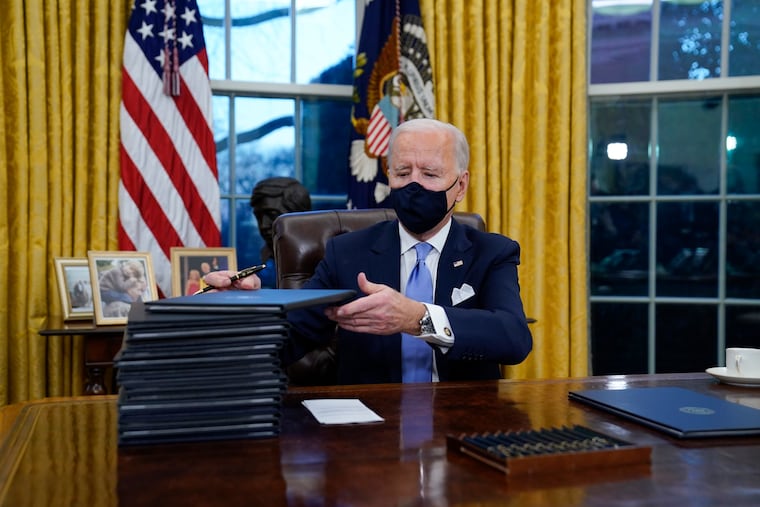After inauguration, President Biden extended freeze on student loan payments until Sept. 30
President Biden has extended the freeze on payments for student loans.

In one of his first actions as president, Joe Biden on Wednesday extended the freeze on student loan payments until the end of September, hoping to forestall new pressure on borrowers amid the economic turmoil caused by the pandemic.
Biden signed an executive order shortly after his inauguration, pushing back the moratorium until Sept. 30.
College graduates nationally are carrying $1.6 trillion in student loans, the largest amount of consumer debt carried by Americans except for mortgages. The average debt is $33,000.
» READ MORE: Joe Biden becomes president with a plea that ‘politics doesn’t have to be a raging fire’
Without an extension, an estimated 22 million borrowers were facing a resumption of payments on federal loans in February. When COVID-19 hit last year, then-President Donald Trump and Congress suspended all loan payments, stopped collecting on borrowers who had defaulted, and decreed that interest would stop accruing. The freeze has been continually extended but was to expire at the end of this month.
Biden campaigned on a platform of striking $10,000 from the debt of every federal loan borrower.
In another major change, he has proposed overhauling the underutilized program that grants loan forgiveness to people who take on public service jobs, such as teaching or nursing. His proposal would give $10,000 in student loan forgiveness a year for up to five years to borrowers in the qualifying positions.
This would replace the current program that nominally wiped out all debt after 10 years, but has assisted only a relative handful of debtors due to bureaucratic obstacles.
His proposals could meet with opposition from both the left and right. Democratic Sens. Elizabeth Warren of Massachusetts and Chuck Schumer of New York have urged a reduction of $50,000 in student debt per borrower — five times Biden’s figure. And Republicans have said Biden’s program was already far too costly.
Biden would also restore the ability of borrowers to get free of their loans by filing for bankruptcy. President George W. Bush and Congress explicitly forbade this in 2005.
Bankruptcy discharge is among the least expensive of the Biden proposals, according to Mark Kantrowitz, an expert on college financial issues.
Congress would have to repeal the section of the U.S. Bankruptcy Code that provides the “exception to discharge” for federal and private student loans. The cost of bankruptcy discharge totals $30 billion over 10 years, he estimated.
» READ MORE: Biden fans celebrate in an eerie, locked-down Washington: ‘We’re not going to be intimidated’
Thomas Gokey, an organizer with the Debt Collective, which has lobbied for “debt strikes” among college graduates, said Biden should wipe out all debt.
“We have always been told that the sky would fall if people stopped paying their student loans. Now we know that is not true. Joe Biden should use this moratorium to cancel all federal student debt using the authority Congress had already granted him to do this,” Gokey said.
Biden, however, has said he found it “pretty questionable” that presidents have the power to cancel debt without the consent of Congress. “I’d be unlikely to do that,” he said, referring to taking such unilateral action.